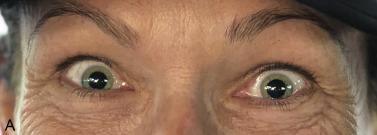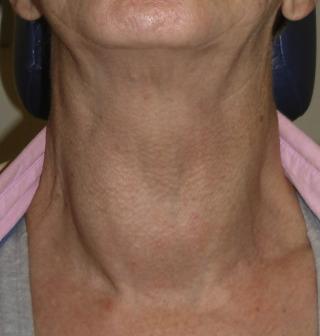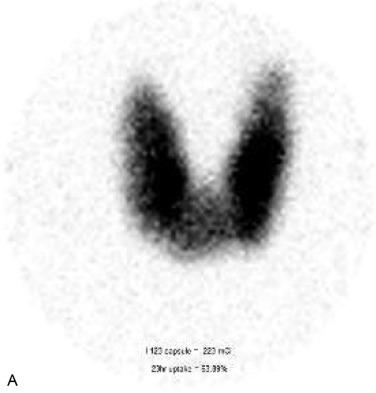Physical Address
304 North Cardinal St.
Dorchester Center, MA 02124
Primary hyperthyroidism is a condition in which the thyroid gland synthesizes and secretes inappropriately high levels of thyroid hormone(s), causing signs and symptoms of hypermetabolism and excess sympathetic nervous system activity. The term hyperthyroidism is distinct from thyrotoxicosis, a clinical state in which there is an inappropriately high thyroid hormone action in tissues. Thyrotoxicosis can result from hyperthyroidism as well as from other etiologies. Patients with subacute, painless, or radiation-induced thyroiditis, excess thyroid hormone ingestion, struma ovarii, and functional metastatic thyroid cancer are examples of those who have thyrotoxicosis that is not attributed to hyperthyroidism. The causes of hyperthyroidism include Graves’ disease, toxic multinodular goiter, a solitary toxic adenomatous nodule, viral infections, autoimmune (Hashimoto's) thyroiditis, autoimmune- (Hashimoto’s), amiodarone-induced thyrotoxicosis, and very rarely, a thyroid-stimulating hormone(TSH)–producing pituitary tumor. The overall prevalence of hyperthyroidism is 1.3% in the U.S. population. It occurs in 2% of women and 0.5% of men, and its prevalence can be as high as 5% in older women. This chapter focuses on the clinical presentation, diagnosis, and surgical management of hyperthyroidism.
The excess synthesis and secretion of thyroid hormone that occur in patients with hyperthyroidism may produce a variety of clinical manifestations and findings on physical examination ( Figures 8.1 and 8.2 ). Elderly patients are more likely to present with subtle symptoms of thyrotoxicosis such as asthenia, fatigue, and weakness, and a syndrome referred to as apathetic hyperthyroidism . Elderly patients are also more likely to present with cardiovascular manifestations of hyperthyroidism such as atrial fibrillation, ischemic heart disease, and congestive heart failure.


The best initial screening test for suspected thyrotoxicosis is a serum TSH level (see Chapter 3 , Thyroid Physiology and Thyroid Function Testing). With the rare exception of a TSH-secreting pituitary tumor, patients with hyperthyroidism will have a low serum TSH level. In patients whose serum TSH level is found to be low, a free T4 (FT4) and a free T3 (FT3) level should be measured to help determine the severity of hyperthyroidism. Patients with a low serum TSH level and normal FT4 and FT3 levels are defined as having subclinical hyperthyroidism. A FT3 level is important to make a diagnosis of “T3 thyrotoxicosis” in a patient with a suppressed serum TSH level and a normal FT4 level. In most patients, T3 thyrotoxicosis is an early manifestation of Graves’ disease.
Once the diagnosis of primary thyroid-mediated hyperthyroidism is confirmed biochemically (low TSH with normal or elevated T4, T3), the etiology of hyperthyroidism should be determined. If clinical examination does not readily reveal the etiology, such as ophthalmopathy associated with Graves’ disease, thyroid uptake scintigraphy with iodine-123 ( 123 I) or technetium-99m ( 99m Tc) can be helpful in determining the cause of hyperthyroidism. Thyroid uptake is elevated in patients with Graves’ disease and may be elevated or normal in patients with toxic multinodular goiter or a solitary toxic nodule. It is low or undetectable in patients with thyrotoxicosis from thyroiditis. Thyroid scintigraphy typically demonstrates diffuse symmetrical uptake in patients with Graves’ disease, heterogeneous uptake in patients with toxic multinodular goiter (the scintigraphic regions on functional scanning may not necessarily correspond to the areas of gross nodularity on ultrasound), and a single area of hyperfunction with a variable degree of suppression of the remainder of the thyroid gland in patients with a solitary toxic nodule ( Figure 8.3 ). Measurement of thyroid-stimulating immunoglobulin (TSI) or TSH receptor antibody (TRAb) may help establish a diagnosis of Graves’ disease when radioiodine scanning is contraindicated or cannot be obtained in patients who have recently received iodinated contrast for a computed tomography (CT) scan or who are on antithyroid medications to treat the hyperthyroidism. Measurement of thyroid peroxidase antibody (TPOAb) may support a diagnosis of thyrotoxicosis due to Hashimoto’s thyroiditis.

Graves’ disease is an autoimmune disorder with familial predisposition. It is clinically characterized by hyperthyroidism associated with ophthalmopathy or dermopathy with anti-TSH receptor antibodies (TRAb) directed against the TSH receptor with receptor stimulation. TRAb activates TSH receptors in the membrane of the follicular epithelial cells of the thyroid gland, resulting in excess synthesis and secretion of thyroid hormone and growth of the thyroid gland.
The most common cause of hyperthyroidism in iodine-replete regions is Graves’ disease with an annual incidence estimated to be 30 to 38 per 100,000 population, occurring more frequently in women than men. Its peak incidence is usually between the ages of 30 and 60 years, with an increased incidence in African Americans. It can be associated with other autoimmune diseases such as rheumatoid arthritis, systemic lupus erythematosus, chronic lymphocytic thyroiditis, Sjögren’s syndrome, vitiligo, pernicious anemia, type 1 diabetes mellitus, Addison’s disease, myasthenia gravis, and idiopathic thrombocytopenic purpura. It is important to be aware of such associated disorders and potential comorbidities when surgery is being considered.
The clinical manifestations of Graves’ disease include symptoms and signs of thyrotoxicosis ( Boxes 8.1 and 8.2 ), a diffuse symmetrical goiter, often with a palpable thrill or an audible bruit, a variable degree of presence of extrathyroidal manifestations such as ophthalmopathy (see Figure 8.1 ), dermopathy such as pretibial myxedema, and acropachy. Extrathyroidal manifestations occur as a result of cellular infiltration and glycosaminoglycan deposition in the soft tissues, such as extraocular muscles and retroorbital fat, in response to antibody reactions to tissue antigens, which crossreact with the TSH receptor in the thyroid gland.
Palpitations
Nervousness
Restlessness
Weight loss
Increased appetite
Anxiety
Irritability
Emotional lability
Heat intolerance
Increased sweating
Fatigue
Muscle weakness
Insomnia
Thinning of the hair and hair loss
Brittle nails
Increased bowel movements
Irregular menses
Impaired fertility
Osteoporosis and increased fracture risk
Atrial fibrillation or other supraventricular arrhythmias
Congestive heart failure
Male gynecomastia and erectile dysfunction
Stare
Lid lag
Tachycardia
Irregularly irregular pulse
Systolic hypertension
Proximal muscle weakness
Hyperreflexia
Resting tremor
Warm, moist skin
Thin, fine hair
Onycholysis
Clinically relevant ophthalmopathy occurs in 20% to 30% of patients with Graves’ disease and is vision-threatening in 3% to 5%. It is more common in cigarette smokers and patients with higher levels of TRAb. Ophthalmopathy results from antibody-mediated inflammation of the extraocular muscles, retroorbital fat and connective tissue, and the optic nerve. Stare, lid lag, and eyelid retraction are manifestations of excess sympathetic nervous system stimulation of the levator palpebrae superioris muscles (see Figure 8.1 ) and may occur in patients with hyperthyroidism due to all causes, but only patients with Graves’ disease have ophthalmopathy. Periorbital edema, chemosis, exophthalmos, and extraocular muscle weakness are more specific manifestations of Graves’ ophthalmopathy. Patients may experience a gritty feeling in the eyes, eye pain, photophobia, tearing, diplopia, and decreased visual acuity. These symptoms should be queried during the patient history. Corneal ulcerations may result from proptosis and lid retraction, and severe proptosis can cause optic neuropathy and blindness.
Pretibial myxedema occurs in 0.5% to 4.3% of patients with Graves’ disease. It is an infiltrative dermopathy most often involving the skin of the legs. It is manifested by painful, pruritic, raised plaque-like violaceous and hyperpigmented lesions that have the texture of an orange peel. Acropachy occurs in less than 1% of patients with Graves’ disease and is manifested by clubbing and periosteal new bone formation of the metacarpal bones and the phalanges.
The diagnosis of Graves’ disease is established by the association of hyperthyroidism, a diffuse symmetrical goiter, and presence of ophthalmopathy or dermopathy as described earlier. In the absence of ophthalmopathy or dermopathy, abnormal levels of TRAb or TSI levels will confirm the diagnosis; however, they may not always be elevated. Thyroid scintigraphy is also helpful in confirming the diagnosis ( Fig. 8.3 ) but not always necessary if a clinical or laboratory diagnosis can be made. If obtained it will demonstrate diffuse increased uptake. Measurement of thyroid uptake and thyroid scintigraphy are primarily of value in helping differentiate thyrotoxicosis caused by Graves’ disease from toxic multinodular goiter, a solitary toxic adenoma, or thyroiditis. Differentiating the etiology of hyperthyroidism is necessary in management, especially surgical planning. Thyroid ultrasonography should be performed to further elucidate the etiology, with recognition that patients with Graves’ disease can also harbor thyroid malignancy.
The goals of therapy for Graves’ disease are rapid amelioration of symptoms and prevention of recurrent hyperthyroidism. There are three therapeutic alternatives for Graves’ disease: antithyroid drugs (ATDs), radioactive iodine (RAI) ablation, and thyroidectomy. Each modality has its own advantages and disadvantages. Patient, physician, institutional, or geographical preferences often influence the choice of therapy. In the United States, radioiodine ablation has traditionally been the primary treatment used; however, a 2011 survey indicates that there has been a trend toward increasing the long-term use of ATD in lieu of RAI. In Europe, Japan, and South America, prolonged ATD therapy is a preferred option.
The initial treatment of overt hyperthyroidism from Graves’ disease involves immediate initiation of an ATD. The ATDs that are used are the thionamide agents, propylthiouracil and methimazole. Both agents decrease thyroid hormone synthesis and reestablish a euthyroid state in 3 to 8 weeks. A beta-blocker is often added for the rapid amelioration of symptoms attributable to excess sympathetic nervous system activity such as palpitations, tachycardia, tremor, heat intolerance, diaphoresis, and anxiety. Permanent remission of Graves’ disease occurs in 20% to 50% of patients after 12 to 18 months of therapy, typically in patients with smaller goiters and with less severe hyperthyroidism. The relapse rate has been reported to be 48%, with the risk of relapse increasing with disease severity.
Graves’ disease patients who relapse after discontinuation of ATD can be retreated if the goal is long-term ATD therapy. However, in the United States, lifelong administration of ATDs is seldom used as the definitive therapy for Graves’ disease. ATDs are routinely used for preoperative preparation. Minor adverse reactions to ATDs occur in approximately 5% of patients and include rash, urticaria, arthralgia, fever, anorexia, nausea, and abnormalities of taste and smell. Major adverse effects include agranulocytosis, which occurs in approximately 0.1% to 0.3% of patients, and hepatotoxicity, an even rarer complication, which may be fatal. Methimazole is the preferred drug due to more convenient dosing but also because of the higher incidence of hepatotoxicity and risk of fatal hepatic necrosis with liver failure associated with propylthiouracil. However, propylthiouracil is preferred for the management of Graves’ disease during pregnancy because methimazole has been associated with birth defects.
Become a Clinical Tree membership for Full access and enjoy Unlimited articles
If you are a member. Log in here